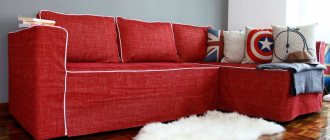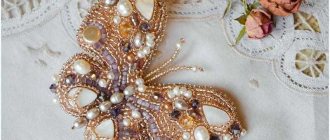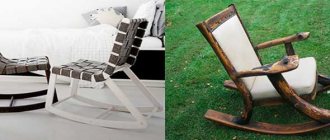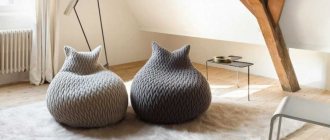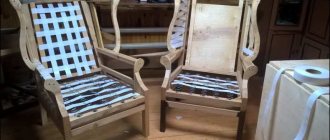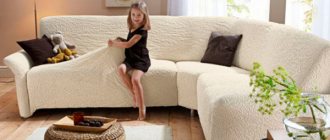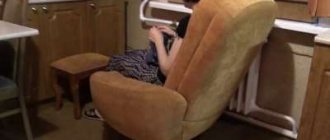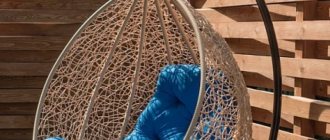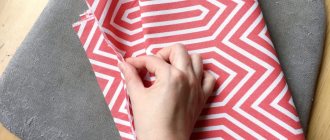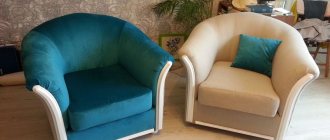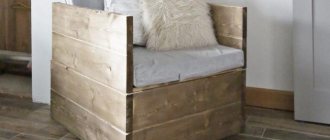Sewing a cover for a chair solves several problems at once. Firstly, with the help of such a protective product you can protect your furniture from contamination. Secondly, if this piece of furniture is already old, then with the help of a cover you can reliably hide scuffs or stains. Thirdly, if you are changing the decor, then new hand-sewn chair covers will help transform the room in accordance with the changed style of the room.
Skirt trim gives a more subtle look than formal trim. It is well suited for situations where you need to hide scratched or unattractive legs. Since the skirt is sewn separately, it is easy to make and will hold up better if hung from the finished cover. It is worth noting that the manufacturing procedure is the same regardless of whether you are sewing a cover for a chair or a sofa.
This page provides detailed step-by-step instructions on how to sew a chair cover yourself.
Why do you need a chair cover?
Special chair covers perform several functions at once. They protect the upholstery from scuffs, and the furniture from damage by children, animals or random objects.
Covers protect furniture from damage by children or pets.
By choosing the appropriate color for the case, you can place color accents in the interior and completely change the style direction. If you choose shades that match the carpet or wallpaper, you will feel a sense of calm, harmony and homeliness.
You can harmonize the interior or place color accents.
It is much easier to wash the cover in the washing machine than to clean the upholstery of the chair. If you have stubborn stains, you can sew a new fabric cover for the chair. To do this, when purchasing fabric, purchase 1.5-2 times more than planned. This way you will have material left to sew another cover in case of urgent need.
It is much easier to wash a cover than to clean the furniture itself.
Recommendations and tips
Before starting work, you need to take a closer look at the room where the updated chair will stand, its interior, shades and the atmosphere that it can create after making a new cover. You should try to imagine a finished composition. All this will help in determining the color and material with which you will need to work.
When selecting fabric, it is important to pay attention only to durable material that will not deform during use. This choice can not only make it easier to grind the material, but will also serve to increase its use. In the case when sewing such a product is the first experience, it is advisable not to choose fabric with clear prints, large-sized designs and checkered patterns, since fitting it will be quite difficult and time-consuming.
Product for computer chair
For people who have little sewing experience, it is recommended to start by sewing a bedspread for a chair. This product will serve as a little practice before making a cover, which will be a little more complicated. An activity like this will help you get better at it, as well as understand all the stages of manufacturing.
Advantages and disadvantages of use
Using furniture covers has a number of advantages.
- Savings in the family budget are obvious. You do not need to pay a tailoring shop for work and choose from the fabrics that they have in stock. You can choose the material you like and do everything yourself.
- You can give free rein to your imagination and decorate the product to your taste.
- Sewing allows you to acquire a lot of new skills in creating patterns, sewing, embroidery, decorating, and even choosing harmonious shades to create an interior.
- You will have an exclusive product that no one else has.
- There is no need to adjust and hem the product, as is the case with purchased covers of standard sizes. You work strictly according to your pattern with individual parameters.
- It's easier to clean upholstery than a chair. You can always soak or throw the covers in the washing machine. This is more convenient than removing stains directly on the chair and worrying about the furniture becoming damp over time.
There are many benefits to making your own chair cover.
Of course, one cannot fail to mention the shortcomings. But there are few of them:
- Time. You will have to invest personal time. Especially if you are new to sewing.
- It may not turn out the way you wanted the first time. But with the acquisition of skills and experience, your cases will turn out better and of higher quality.
The disadvantage is that the result may not be as expected.
Fabric selection
Before purchasing fabric for a chair cover, you should pay attention to some criteria that will help in your choice, namely:
- Strength. You should only focus on materials with high strength;
- Fabric color. In this case, you can rely on imagination and taste, but it is best to select the shade of the material according to the color scheme of the room’s interior;
- Fabric preparation. Immediately after purchasing, you need to wash and dry the fabric; if this is not done, the sewn cover will shrink during the washing process and will no longer fit the size of the chair.
The product can be attached with an elastic band
How to sew a chair cover with your own hands
Once you have decided to create “clothes” for the chairs yourself, you need to take a number of steps. Decide on the design of the future product and what you will need to create it. Using these instructions, it is also easy to sew a cover for a computer chair with your own hands.
You can even sew a cover for a computer chair with your own hands.
Design selection
Depending on the “character” of your room or office interior, there are different styles. To ensure that the covers look harmonious against the background of other furniture and decor, choose the solution that is closest to you.
- Patchwork is pieces of fabric sewn together in the shape of geometric shapes. You can use both bright and pastel colors of the material. And even mix them with each other. You must have skills in sewing because it is a methodical job that requires precision and accuracy.
- Loft is expressed in the natural textures of the material. It can be fur, suede, linen. Raw edges, rough seams, and textured fabrics are welcome. This is an excellent solution for sewing a cover for an office chair.
- Shabby chic is characterized by antiquity and a light touch of antiquity. Satin, silk and cotton fabrics with small floral patterns will look good here. Plain and printed materials are especially harmoniously combined. Shabby chic loves bows, frills, folds, ribbons and tassels.
- The Baroque style requires pomp and royal splendor. These are elegant frills, flounces and deep folds. Here you get the impression that you are sitting not in a chair, but on a royal throne.
Preparation of materials and tools
To sew a chair cover with your own hands you will need:
- sewing needles or sewing machine;
- pins with a plug at the end for pinning the pattern to the fabric;
- threads for sewing to match the selected fabric;
- tailor's chalk or dry soap;
- fabric scissors;
- tape measure;
- millimeter fabric;
- furniture staples;
- decor
Before work, prepare all the necessary tools.
Cotton, nubuck, velor, flock and relax can be used as materials to create a cover.
Sewing stages
Each stage has features and nuances. First you need to measure the furniture and take measurements. Then draw a pattern, cut the fabric and sew the product. Re-reading and refreshing your memory of all the sewing steps is useful not only for beginners, but also for experienced craftsmen.
Sewing a cover has its own nuances.
Pattern creation and cutting
Be very careful when measuring the dimensions of the chair. This determines how accurately the finished product will follow the contours of the furniture. Immediately on the pattern, mark the areas where the seams will go. Draw places for future frills, folds and hems.
The dimensions of the chair must be carefully measured.
To prevent the fabric from wrinkling on the armrests and back, it is necessary to make darts. Sign the patterns together so you don't confuse them.
You can make a separate pattern for the armrests.
Make a pattern using your measurements on graph paper. The armrests are sewn double. This makes them more wear-resistant. Therefore, cut out the outer and inner sides at once.
Patterns are made based on the measurements.
Spread the fabric, attach the pattern so that the material is used as economically as possible. Trace with chalk or soap and cut out the pieces with an additional 2-5cm seam allowance. Leave about another 20cm at the bottom for hems. It is better to cut off the excess than to sew it on. Iron the cut fabric to make it easier to work with.
Lay out the pattern pieces on the fabric.
Fit
Fitting is the next step after creating the pattern. Here you polish all the nuances and correct minor defects.
- Lay out the cut fabric on the chair so that the piece matches its location. Pin the patterns with pins.
- Flatten the fabric at the folds and draw future seams.
- If the fabric does not fit the chair well enough, forms a “bubble” or hangs unattractively, make a dart in this place.
- Look at how the fabric lays at the seams so that it does not puff up or gather.
- Here you can sew darts so that you never have to return to them.
During the fitting process, you need to level the fabric on the chair.
Sewing
Sewing all the parts together is an activity for the patient and hardworking.
- To prevent the finished product from becoming skewed, make the seams strictly along the lines.
- First of all, baste the darts and frills.
- From the wrong side, sweep the parts of the armrests together. Sew and cut the corners so that the piece can be beautifully turned right side out.
- Baste the armrests with the seat piece.
- Attach the backrest with the inside to the seat.
- Add a hem, carefully arrange all the gathers.
- Turn the cover right side out and try it on the chair. At this stage, inaccuracies can be adjusted.
- When you are completely satisfied with the result, you can sew all the basted seams on a machine.
During the sewing process, all parts are ground together.
Decor features
Various pieces of fabric, ribbons, trim, soutache, and eye-catching buttons are used for decoration. The main thing is that the decorations do not overload the furniture and do not interfere with your sitting. Therefore, for decoration, those parts of the chair with which a person has least contact are used. This could be the bottom of the furniture, the bottom of the seat and armrests, or the back of the backrest.
The free part of the chair is used for decoration.
You can make an applique, sew it with threads or put it on hot glue. But remember that the covers will have to be washed periodically.
Preparation of materials and tools
To properly make a bedspread for a chair with your own hands, you need to prepare for the work, and also carefully choose the material. For sewing you will need the following tools:
- sewing machine, needle and pins for pinning the pattern of the chair cover;
- furniture staples;
- paper pattern;
- threads;
- pencil, chalk, soap;
- scissors;
- measuring tape;
- graph paper;
- zippers, decorative elements, fasteners.
Of course, you can try to sew a bedspread for a chair with your own hands, but you need to do this in such a way as not to spoil the expensive fabric. To begin with, it is better to practice using rough material - an ordinary sheet.
In order for the furniture to look presentable, you need to choose the right material. It should fit well on the base, not wrinkle, be resistant to abrasion, and be easy to clean or machine washable. Typically the following fabrics are used for sewing:
- Cotton. The advantage of this material is its naturalness. It allows air to pass through well, does not cause allergies, but quickly wears out and tears, because it does not contain artificial fibers. Cotton shrinks after washing and may shrink in size.
- Velours. The fabric is soft and has a beautiful appearance. The fabric is wear-resistant, easy to care for, but accumulates dust. Dirt stains cannot always be removed without damaging the material.
- Flock. It is dense, durable, but at the same time soft and delicate. The material is not subject to deformation and can be used for many years. The product does not fade when exposed to direct sunlight and is resistant to moisture.
- Relax. This fabric is easy to care for and abrasion resistant. Its bottom layer is made of cotton and polyester, the top layer is made of polyamide pile. They are connected to each other using rubber. This material can be cleaned with detergents.
- Nubuck. It is pleasant to the touch, soft, and has a beautiful, velvety surface. The fabric can last for decades.
Using an easy way to sew a chair cover, you can use other materials: linen canvas, jacquard, microfiber, chenille, satin, silk, upholstery fabric.
Sewing supplies
Cotton
Flock
Relax
Jacquard
Linen canvas
Velours
Silk
Natural nubuck
Chenille
Microfiber
Upholstery fabric
How to update an old chair cover
If you want to update an old cover, you first need to wash it and assess the degree of wear.
- Mark all shabby and ugly places. If you have leftovers of this material, it makes sense to replace some part and sew a new one.
- The fastest way to update an old cover is to sew on it a hem or frills from a material that matches the color.
- The product can be made in two colors. Sew some details in contrasting colors to the old fabric. For example, make the armrests and hem of a different texture. Decorate the back with the same pieces of fabric.
An old case can be updated in many ways.
Making a chair cover with your own hands is fun. This will breathe new life into a familiar interior and extend the life of your favorite furniture.
Choosing a suitable product design
Before sewing a chair cover with your own hands, you should think about what fabric to choose so that the furniture fits into the overall interior. The design of the product may be different, but each style has its own characteristics. They are presented in the table.
| Design type | Characteristic |
| Patchwork | This cover is a combination of a large number of patches of different colors and shapes. The palette of shades is usually bright, but if the product will be used in Provence or Scandinavian style, then it is better to give preference to pastel, muted tones. This DIY chair cover will add personality to the room. It looks festive and impressive. For a beginner, sewing a product in the patchwork style will be somewhat difficult, since it involves sewing together a large number of fragments, which must first be folded in a certain order and overcast. |
| Loft | The loft style combines wide space, maximum sunny color and rough wall decoration (brick, concrete). Fur products are especially popular for him. This type of chair cover must be made carefully with your own hands. Natural material is expensive, but it is soft, cozy and warm. High-quality faux fur is not inferior in properties to it. The length of the pile may vary. As for color, in this style it is better to use light, airy shades. A fur cover will make the interior rich and more presentable, but it is important not to overdo it. |
| Shabby chic | This style is characterized by the use of faded and worn fabrics to create an antique effect. Here it is better to use muted shades and light floral patterns. Geometric patterns in this case are inappropriate, as are bright colors. To sew the cover, you can use silk or satin fabric. Brushes and frills are suitable for decoration. |
| Baroque | Covers with frills and flounces are appropriate for this style. They add romance. Folds can be full or incomplete, and can be on the front of the chair or on the sides. |
Loft
Patchwork
Baroque Shabby chic
Photo ideas for chair covers
Is it possible without a pattern?
A cover sewn without a pattern may become slightly deformed and lose its proper appearance. That is why the cover for the chair should be sewn according to patterns, so that during the work you do not waste a large amount of material and, as a result, the cover looks high-quality and neat.
Seashell chair cover
Thus, sewing a cover for a car seat or home furniture is not difficult. Using the patterns provided on the Internet, in a couple of minutes you can make a drawing and sew a protective product for a chair, rocking chair, and even for a sofa element.
Choosing material
The modern market is quite diverse in the choice of textile products. And even the most capricious housewives can find something they like.
Bright chair covers will be an excellent color accent.
And in order to sew a furniture cover for a sofa or a cover for a computer chair, the following alternatives will be optimal.
- Velours. The material is quite soft with a velvety texture. However, unlike velvet, it is a more budget option. Due to the varied arrangement of the pile, it is combed, laid and smoothed in different ways.
According to the type of production, velor can be smooth, embossed and shaped.
The fabric is easy to care for. Has hypoallergenic properties. This type of material is wear-resistant, and stains are removed quite easily.
The fabric for the future cape should be chosen in accordance with the existing interior style.
- Cotton. It has an important quality - naturalness. As a result, the fabric belongs to the category of “breathable” and environmentally friendly fabrics.
Since cotton is susceptible to coloring, covers made from this material are bright.
The material is short-lived due to the absence of artificial fiber. Cotton fabric also shrinks after washing.
The main criterion for choosing a cover for children's furniture is the environmental friendliness and hypoallergenic nature of the fabric.
- Flock. Soft, delicate, but at the same time quite durable material, which makes it a worthy option for chair covers. The material does not deform, which means that even with long-term use, a bedspread made of this fabric can retain its original appearance.
This modern fabric is similar to velvet.
Also, the advantages of flock include such qualities as ease of operation and subsequent care, water-repellent properties, and resistance to sunlight.
High-quality flock has a three-layer structure, which is quite resistant to wear, stretching and has a large margin of safety.
Insulated cover: purpose, materials
Insulated accessories protect against moisture penetration and sudden temperature changes. In such a case there will be no fear of falling from a small height.
Materials for insulation:
- Foam rubber. Not the most reliable sealant - it dries out and crumbles. Prevents sudden temperature changes and protects against mechanical damage.
- Foam. Unlike foam rubber, foam is stiffer and conducts less heat. Foam is more durable. Covers with a foam seal are designed so that the foam sheet can be replaced independently.
The cheapest and easiest way is to use 10 mm foam rubber as padding. It will not only protect against frost, but also avoid mechanical damage.
Thick padding polyester, which can be laid in layers, is also suitable for stuffing.
Also a good option for truly northern cities is the use of penofol. This material is of course not cheap and to save money you can use 3 or 5mm foam. and 5 mm. foam rubber.
The same materials are used for the top and lining as for the rest of the cases.
You can sew zippers on the armrest areas, making it easier to remove and put on the covers. There are brands of cars where the backrests tilt back in individual elements. Normal types of cases will not fit under them.
Some cars have airbags in the end parts of the backrests. If you put covers on top, they will not be able to open. For this reason, the upholstery on such seats will simply have to be cleaned.
If you still decide to make covers, then leave slits at the points where the pillows fly out. They can be stitched with cotton thread, which will tear easily. The work is simple and can be done independently.
Foreign cars can be equipped with end airbags. In order not to reduce the level of protection for passengers and the driver, it is necessary to ensure that the seams at the exit points of the airbags are sewn with weak threads. You can also leave neat machined slits for this operation.
How to upholster a sofa or photo instructions for reupholstery Part 2
After carrying out the preparatory work for reupholstering, you should calculate the cover for upholstered furniture. Upholstering a book sofa will not cause you any particular difficulties, but for covers of complex shapes that have large armrests or corner sofas, careful calculation of the pattern of the future cover is necessary. Having chosen the desired type of fabric, you can roughly calculate the material consumption based on the sum of double the width and double the length of the sofa .
For an accurate calculation, measure the old cover or use a tape measure to measure the dimensions of the sofa, which after restoration of the frame may differ slightly from the old dimensions.
Take fabric with a margin of 20% more than necessary. If there is any excess fabric left over, it can easily be used to make decorative pillows.
For example, if a sofa is 1.6 m wide and 2 m long, then a piece of fabric 7.2 m long will be used with a standard width of 1.5 m. In each individual case, it is better to measure the upholstered furniture. For corner sofas you will need much more stock. If this is your first time making a pattern, then measure each detail separately and apply their designs on a checkered piece of paper, taking into account the split line. For patterned fabrics, be sure to consider pattern matching.
If the geometric image is not covered, for example, with stripes, the work becomes more complicated. In this case, the cost and price of upholstery increases, since the strip must not only be directed in one direction, but also the back and seat of the sofa must match the pattern. If you have no sewing experience at all, we do not recommend choosing such fabrics. Upholstering a sofa from plain fabrics or those that have a small pattern will not take you much time or effort. The rule when buying fabric for a cover “+1 m” works; there will be no excess material here, since it’s worth thinking about its supply for minor repairs to individual sections of the sofa in the future.
Making a pattern can be similar to the old cover, if you removed it carefully, or creating a new one. After drawing up the card, cut it out on paper and transfer it to the back of the furniture fabric using chalk, taking into account the direction of the cut. It is always necessary to leave seam allowances, and they range from 2 to 5 cm. A few more cm will be spent on folding the fabric for fastening with a stapler. Each sofa is unique in its shape and size, so there is simply no universal pattern. But there are some tips that will help you to reupholster your sofa:
- Large allowances will allow you to form a pattern directly onto the product; cut off the excess with scissors.
- The more tightly you plan the pattern, the greater the likelihood of making mistakes, especially for a sofa with a complex shape. Even with the rectangular appearance of the sofa, its cover can be quite difficult to manufacture.
- The cover must initially be made free, because the upholstery of the sofa in the workshop is not done according to strict patterns, but the fabric is stretched and nailed with nails or staples. The free case will give you the opportunity to form the final shapes directly onto the product.
Making a cover occurs in two ways, depending on your seamstress skills and the availability of a sewing machine. The first method is suitable only for sofas with a simple mechanism and a simple geometric shape - the so-called. seamless. Sometimes the fabric is not processed, but stretched, folding the ends of the fabric in half, and immediately nailing them to the frame. But this method is only suitable if this is not your first time doing constriction.
It’s better to do everything properly so that over time the cover does not get tight, and to ensure the evenness of the product’s shape. If the sofa has a complex shape, then make a rough cover from cotton fabric, so as not to otherwise spoil the expensive furniture fabric. Buy threads for the case that are strong and reinforced. When sewing a cover, stitch the corners or the junction of several parts twice. This will make the upholstery durable while allowing the fabric to stretch significantly, especially on the seat.
The sewing machine should, if possible, be taken from an old manual sewing machine. Only industrial machines will be of better quality. If you have an ordinary household machine, then complex sofa upholstery will require combining fabric in two or even three layers. Sometimes your machine can't handle this, especially when choosing thick (leather) or fluffy fabrics (vinyl). You can even break the needle on the mechanism, but you don’t have to sew every part together. Think about how to avoid multi-layer joints.
Decorative elements can complement the new cover: belts, ribbons, piping, etc. Unsuccessful seams against the background of such decor will not be particularly noticeable. The armrests can be upholstered with special buttons of different shapes, and the ugly old sofa legs can be covered with the so-called. "skirt". Sewing it is not difficult, especially if there are leftover furniture fabrics. To keep the skirt firmly in place, you need to place cardboard under the bottom. The decor will be complemented by numerous pillows, which are not difficult to sew. Place the remaining filler inside.
The covers are nailed down using a construction stapler on staples or small nails (more discreetly) every 3 cm and in inconspicuous places. And if you have children or pets who constantly get the upholstery dirty, then consider a removable cover. And so, your updated sofa is ready!
By leaving a comment you agree to the Privacy Policy
Preparing to sew covers
Working on creating furniture “clothes” with your own hands requires certain preparation, which consists of several steps:
- Material selection;
- Preparation of tools;
- Design selection;
- Creating a pattern;
- Sewing a cover.
Even before starting work, you need to choose the type of future product.
Why do you need a new furniture cover?
The cape acts as a protective barrier when faced with various types of contaminants. Including if the house is “run” by children or there are pets.
As mentioned above, the main function of furniture “clothing” or a sofa cover is protection.
Another important and integral function is interior design.
With the help of a removable furniture cover, you can update the interior of the room every time.
